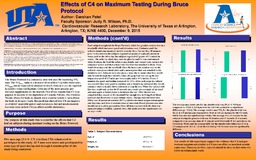
ATTENTION: The works hosted here are being migrated to a new repository that will consolidate resources, improve discoverability, and better show UTA's research impact on the global community. We will update authors as the migration progresses. Please see MavMatrix for more information.
Show simple item record
| dc.contributor.author | Patel, Darshan | |
| dc.date.accessioned | 2017-04-13T21:22:52Z | |
| dc.date.available | 2017-04-13T21:22:52Z | |
| dc.date.issued | 2015 | |
| dc.identifier.uri | http://hdl.handle.net/10106/26610 | |
| dc.description | KINE 4400 | en_us |
| dc.description.abstract | INTRODUCTION: The Bruce Protocol is a commonly used test for determining maximal oxygen consumption (VO2max). The VO2maxvalue is a measure of an athlete’s aerobic endurance. VO2maxcan be reported in absolute terms (L/min) or it can be reported in relative terms (ml/kg/min). C4 is one of the most popular pre-workout supplements on the market. Research has showed that C4 can improve an athletes’ anaerobic power and endurance, but not much research has been done on how C4 can affect aerobic endurance.
PURPOSE: The purpose of this study was to evaluate the effects that C4 had on subjects during maximal exercise testing using the Bruce Protocol.
METHODS: Five men (age 23.4 ±3.71 yrs) from UTA volunteered to participate in this study. All five men were active and participated in some type of sport during and through the 6 months prior to this study. Each subject completed the Bruce Protocol, which is a graded exercise test on a treadmill, which increases speed and elevation every 3 minutes until they could not run anymore. Each subjected completed this test twice: once after drinking a placebo and the other after drinking C4. During each test heart rate (HR), rate of perceived exertion (RPE), relative maximal oxygen consumption (mL/kg/min), and time of exercise were all recorded.
RESULTS: The maximum HR for the placebo trial was 191.6 ±9.0 bpm compared to 191.4 ±5.8 bpm with the C4 trial. This difference was not significant (p= 0.14). The average relative VO2maxfor the placebo trial was 42.12 ±6.9 mL/kg/min compared to 44.16 ±6.8 mL/kg/min for the C4 trial which was also not significantly different
(p= 0.43). The average time of exercise for the subjects during the placebo trial was 11 min ±6 sec compared to an average time of 11 min ±8.4 sec on the C4 trial (p= 0.43) which was also not significantly different. Finally, the average RPE for the placebo trial was 17.4 ±1.5 compared to 18.2 ±1.3 on the C4 trial resulted in no significant difference between the two conditions (p= 0.19).
CONCLUSION: The results of this experiment do not support the claims that C4, when consumed prior to exercise, will improve performance. However, this study evaluated maximal exercise only. Further studies are need to determine if C4 will improve performance during submaximal exercise, such as the type generally involved in a “workout.” | en_US |
| dc.description.sponsorship | Faculty Sponsor, Judy R. Wilson | en_US |
| dc.language.iso | en_US | en_US |
| dc.subject | Maximal exercise | en_US |
| dc.subject | Bruce protocol | en_US |
| dc.subject | Rate of perceived exertion | en_US |
| dc.title | Effects of C4 on Maximum Testing During Bruce Protocol | en_US |
| dc.type | Presentation | en_US |
| dc.publisher.department | Department of Kinesiology, The University of Texas at Arlington | en_us |
| dc.publisher.department | Exercise Science Research Laboratories, The University of Texas at Arlington | en_us |
| dc.publisher.department | Cardiovascular Research Laboratory, The University of Texas at Arlington | en_us |
Files in this item
- Name:
- Patel.pdf
- Size:
- 462.6Kb
- Format:
- PDF
- Description:
- PDF
This item appears in the following Collection(s)
Show simple item record


